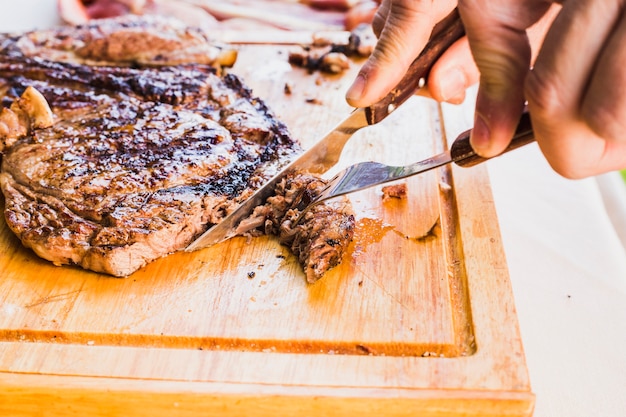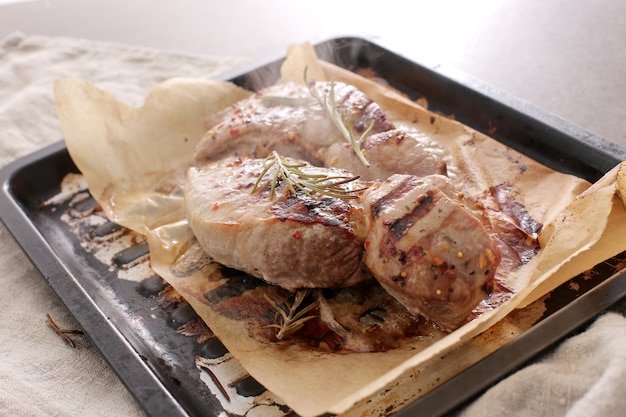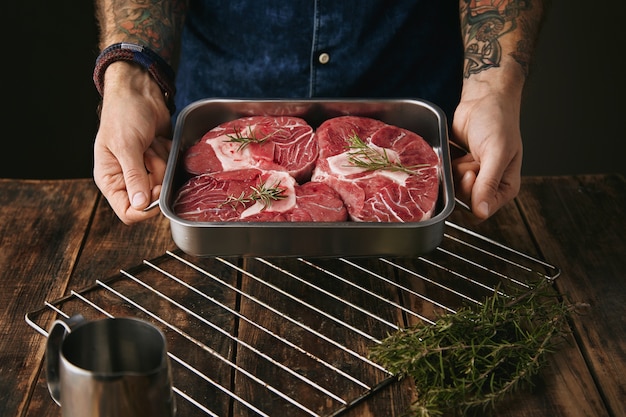Ah, the ribeye steak. A culinary masterpiece, a king among cuts, a symphony of flavour and texture. That irresistible marbling, the promise of a juicy, tender bite – it's enough to make anyone's mouth water. But let's be honest, getting that ribeye cooked to perfection can be a bit of a challenge. Thick cuts, thin cuts, different ovens, different preferences – it's a recipe for culinary chaos. But fear not, my fellow steak enthusiasts, because I'm here to guide you through the process, sharing my hard-earned wisdom and personal experience to ensure your next ribeye is an absolute triumph.
Over the years, I've spent countless hours in the kitchen, experimenting, tweaking, and perfecting my techniques. I've learned that mastering the art of oven-cooked ribeye isn't just about following a recipe; it's about understanding the science behind the process, developing an intuition for your oven, and appreciating the subtle nuances of this extraordinary cut of meat.
So, gather your trusty oven mitts, select a prime ribeye, and let's embark on a journey to achieve that coveted steak perfection.
(Part 1) choosing the right ribeye

The first step to a delicious ribeye is choosing the right one. It's like selecting the perfect bottle of wine – you need a cut with character, a cut that's going to deliver a truly memorable experience.
Thickness Matters
Let's start with thickness. Ribeyes come in a variety of sizes, and the thickness will significantly influence your cooking time. My personal preference is for a ribeye that's about 1.5-2 inches thick. It provides ample surface area for a beautiful sear, allowing the heat to penetrate evenly and resulting in a juicy, tender centre.
Now, if you're dealing with a thinner cut, you'll need to shorten the cooking time to prevent overcooking and dryness. A thick cut, on the other hand, will require a longer cooking time to achieve that coveted perfect doneness. Remember, patience is key!
Marbling is King
Next, let's talk about marbling. Those beautiful streaks of fat are the secret to a ribeye's rich, buttery flavour. When choosing your ribeye, look for a cut with good marbling throughout. Ideally, it should be evenly distributed, not concentrated in just one area. The more marbling, the more flavourful the steak will be – it's a simple truth that every steak enthusiast knows.
Prime Time
And finally, let's address the quality of the cut. If you're looking for the absolute best, go for a prime cut. It's the highest grade, boasting superior marbling and flavour. But if you're on a tighter budget, a select or choice cut will still provide a delicious and satisfying ribeye experience. Remember, quality doesn't always have to come with a hefty price tag.
(Part 2) Getting Ready to Cook

You've got your prime ribeye, now it's time to prepare for the culinary magic. This stage is all about setting the scene for a successful cook.
Preheating is Key
Your trusty oven is your partner in crime here. Preheating it to the right temperature is crucial for a successful and consistent cook. It ensures even heat distribution, allowing the ribeye to cook quickly and efficiently, creating that beautiful sear and juicy interior. I usually preheat my oven to 400°F (200°C) – a temperature that strikes a good balance between heat and cooking time. But feel free to experiment with different temperatures and find what works best for your oven and your preferences.
Seasoning with Love
Now, it's time to add flavour. Salt and pepper are the classic seasonings for a ribeye, but don't hesitate to get creative. I love adding a pinch of garlic powder, paprika, or even a sprinkle of chili flakes for a hint of heat. Remember, less is more! You don't want to overpower the natural flavour of the ribeye.
If you're feeling adventurous, try experimenting with pre-made steak seasoning blends. However, I personally prefer to create my own custom blends. It's a fun way to personalise your dish and discover new flavour combinations.
Rest and Relax
Before you start cooking, let that beautiful ribeye rest. Pop it in the fridge for at least 30 minutes. This allows the steak to relax, reach a more even temperature throughout, and ensures a consistent cook with a juicy centre. It also gives you a chance to pour yourself a glass of wine and unwind.
(Part 3) Cooking the Ribeye to Perfection

Alright, the moment of truth is here. Let's get this steak cooked to perfection!
The Sear
First, we need to give that ribeye a good sear. This is the crucial step that creates that beautiful, crispy crust and seals in the juices. My preferred tool for this task is a cast iron skillet. It boasts incredible heat retention, allowing for a consistent sear. Heat the skillet over high heat for a couple of minutes, then add the ribeye. Sear it for 2-3 minutes per side, just enough to get that irresistible crust without overcooking.
If you don't have a cast iron skillet, a regular skillet or even a baking sheet will do. Just ensure the pan is nice and hot before adding the steak.
Into the Oven
Now, it's time to move the ribeye to the oven. Place it on a baking sheet lined with parchment paper to prevent sticking and make cleanup a breeze. Pop it into the preheated oven and let the magic happen. This is where the cooking time becomes crucial.
Here's a general guide for different doneness levels, but remember, every oven and ribeye is unique, so use a meat thermometer to ensure accuracy:
| Doneness | internal temperature (°F) | Oven Time (approx.) |
|---|---|---|
| Rare | 125-130°F | 10-12 minutes |
| Medium Rare | 130-135°F | 12-14 minutes |
| Medium | 135-140°F | 14-16 minutes |
| Medium Well | 140-145°F | 16-18 minutes |
| Well Done | 145-150°F | 18-20 minutes |
Rest and Serve
Once your ribeye has reached the desired doneness, take it out of the oven and let it rest for 10-15 minutes. This allows the juices to redistribute throughout the steak, resulting in a more tender and flavorful masterpiece. It's a crucial step that many overlook, but it makes a world of difference.
Serve your perfectly cooked ribeye with your favourite sides. mashed potatoes, asparagus, a simple green salad – the possibilities are endless. And don't forget a rich gravy to complete the culinary experience.
(Part 4) Tips and Tricks for Oven-Cooked Ribeye
Now, let's delve into some handy tips and tricks to elevate your oven-cooked ribeye game.
1. Temperature is Key
I can't emphasize this enough. Use a meat thermometer to check the internal temperature of your ribeye. It's the most reliable way to ensure it's cooked to your liking. No more guesswork or overcooked steaks!
2. Don't Overcrowd the Oven
Give each ribeye some space to breathe. If you're cooking multiple steaks, make sure they're not touching each other. This allows for even cooking and prevents steam buildup, ensuring all those steaks reach their full potential.
3. Flip It Once
After searing, flip the ribeye once and leave it in the oven. Resist the urge to flip it multiple times – it disrupts the cooking process and can lead to a dry, tough steak.
4. Let It Rest
We've already touched on this, but it's worth repeating. Let that ribeye rest for 10-15 minutes. The juices will redistribute, resulting in a more flavorful and tender steak. Patience is a virtue, especially in the culinary world.
5. Don't Be Afraid to Experiment
Cooking is all about experimentation. Try different seasonings, different temperatures, different cooking times. Discover what works best for your preferences and your oven. You'll be surprised at the unique flavour combinations you can create.
(Part 5) The Science Behind Oven-cooking ribeye
Let's delve a little deeper into the science behind those perfect oven-cooked ribeyes. Understanding the scientific principles involved can help you achieve more consistent results.
The Maillard Reaction
That beautiful browning you see on the surface of a ribeye is a result of the Maillard reaction. This chemical reaction occurs when sugars and amino acids in food are heated. It produces hundreds of flavorful compounds, giving your steak its irresistible aroma and taste. It's the foundation of that delicious crust.
Protein Denaturation
As your ribeye cooks, the proteins in the meat denature. This means they change shape and structure. This process is responsible for the firm texture of cooked steak. It's the delicate balance of denaturation that creates a steak that's both tender and firm, providing a satisfying textural experience.
Moisture Loss
During cooking, moisture is lost through evaporation. This is why it's crucial to cook the steak to your desired doneness and no more. Overcooking leads to a dry, tough steak, something we want to avoid at all costs.
Fat Rendering
The marbling in a ribeye is made up of fat. As the steak cooks, the fat renders, releasing flavour and moisture. This is why ribeye is so juicy and flavorful. It's the magic of marbling that elevates the ribeye above other cuts of meat.
Temperature Control
The key to a perfectly cooked ribeye is temperature control. By preheating your oven and using a meat thermometer, you can ensure even cooking and achieve your desired doneness. It's the foundation of consistency and predictability in the kitchen.
(Part 6) Common Mistakes to Avoid
We've all been there, those moments of culinary disappointment when the steak is overcooked, dry, or unevenly cooked. Let's learn from those experiences and avoid making the same mistakes.
1. Overcrowding the Oven
Don't crowd your oven. Give each ribeye enough space to cook evenly. Avoid overcrowding to ensure all those beautiful steaks reach their full potential.
2. Not Preheating the Oven
Preheating your oven is essential for even cooking. It ensures the steak cooks quickly and efficiently, preventing inconsistencies and uneven doneness. It's a simple step that makes a big difference.
3. Flipping Too Often
Flipping the ribeye multiple times disrupts the cooking process and can lead to a dry, tough steak. Flip it once after searing and let it cook undisturbed.
4. Not Resting the Steak
Resting the ribeye allows the juices to redistribute throughout the steak, creating a more flavorful and tender experience. Don't rush the process, let it rest for 10-15 minutes.
5. Using a Dirty Grill Pan
A dirty grill pan can affect the sear and overall cooking process. Make sure your pan is clean and seasoned before cooking the ribeye. It's the foundation of a beautiful crust and a delicious sear.
(Part 7) Mastering the Art of Oven-Cooking Ribeye
You've got the basics down, now let's talk about mastering the art of oven-cooked ribeye. It's about practice, patience, and a willingness to experiment.
1. Experiment with Different Temperatures
Don't be afraid to try different oven temperatures. Some prefer a higher temperature for a faster cook, while others prefer a lower temperature for a slower, more even cook. Discover what works best for your preferences and your oven.
2. Try Different Seasoning Blends
Get creative with your seasonings! Try different blends, herbs, and spices. You can even create your own custom blends.
3. Invest in a Good Meat Thermometer
A good meat thermometer is essential for achieving perfectly cooked ribeye. It takes the guesswork out of cooking and ensures that your steak is cooked to your liking.
4. Take Notes
Keep track of your cooking times and temperatures. This will help you replicate your perfect ribeye every time.
5. Have Fun!
Cooking is all about having fun! Don't be afraid to make mistakes and experiment. You'll learn something new each time you cook.
(Part 8) FAQs
1. What if my oven doesn't have a meat thermometer?
If your oven doesn't have a built-in meat thermometer, invest in a separate one. Insert the thermometer into the thickest part of the steak to check the internal temperature.
2. How long should I sear the ribeye for?
Sear the ribeye for 2-3 minutes per side to create a beautiful, crispy crust.
3. Can I cook a ribeye in a cast iron skillet in the oven?
Yes, you can cook a ribeye in a cast iron skillet in the oven. Preheat the skillet in the oven for a few minutes, then add the ribeye and cook as directed.
4. What's the best way to rest a ribeye?
Place the ribeye on a cutting board and cover it loosely with foil to allow the juices to redistribute.
5. What are some good sides to serve with a ribeye steak?
There are many great sides to serve with a ribeye steak. Mashed potatoes, asparagus, green beans, roasted vegetables, and a simple green salad are all popular choices.
I hope this comprehensive guide has provided you with the knowledge and confidence to conquer the world of oven-cooked ribeye. Remember, with practice, patience, and a willingness to experiment, you can create a culinary masterpiece that will impress even the most discerning palate.
Happy cooking!
Everyone is watching

How to Cook Frozen Lobster Tails Perfectly: A Step-by-Step Guide
RecipesLobster. Just the word conjures up images of lavish meals, special occasions, and a taste of luxury. But let's...

Pigs in a Blanket Cooking Time: How Long to Bake for Perfect Results
RecipesAh, pigs in a blanket. Just the name conjures up images of those delightful little parcels of crispy pastry en...

Pork Fillet Cooking Time: How Long to Cook It Perfectly
RecipesPork fillet, or tenderloin as it's sometimes called, is a real favourite in our house. It's so versatile, and...

The Ultimate Guide to Tender, Juicy Pulled Pork
RecipesRight, let's talk pulled pork. It's one of those dishes that just screams "comfort food," doesn't it? I mean...

The Ultimate Guide to Cooking Sweet Potatoes: From Roasting to Mashing
RecipesSweet potatoes. Just the name conjures up images of warm, comforting dishes, bursts of vibrant color, and a to...
